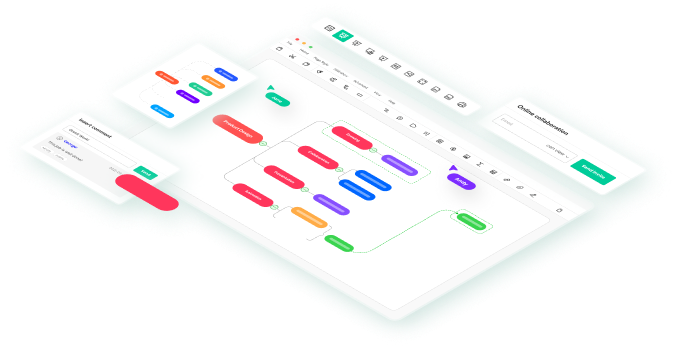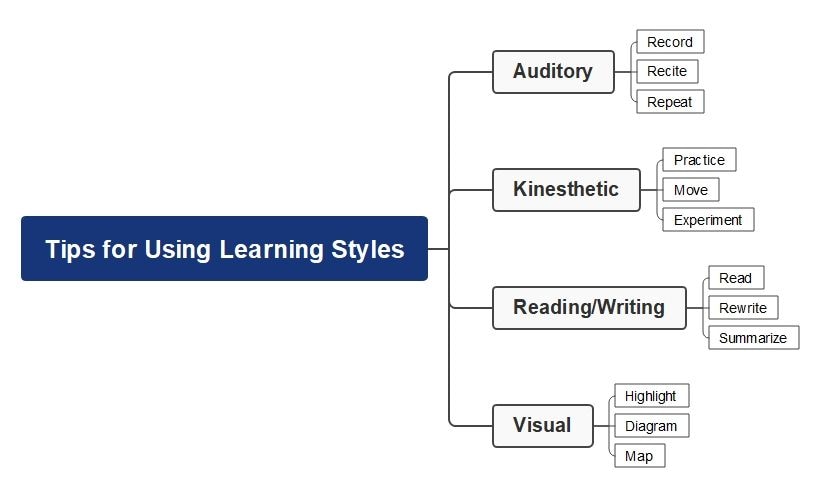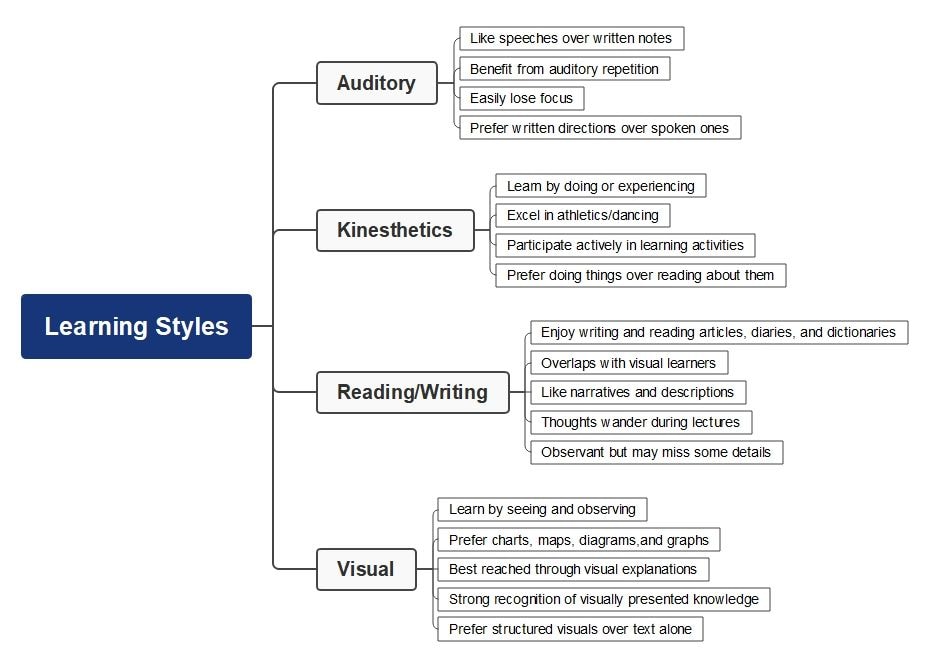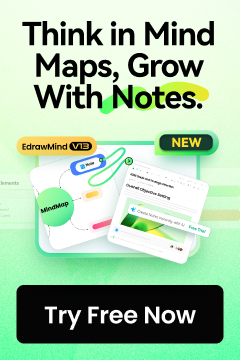Learning styles shape how students absorb, process, and recall information. This guide explains auditory, kinesthetic, reading/writing, and visual learning, as well as how mind maps enhance memory, focus, and study efficiency.
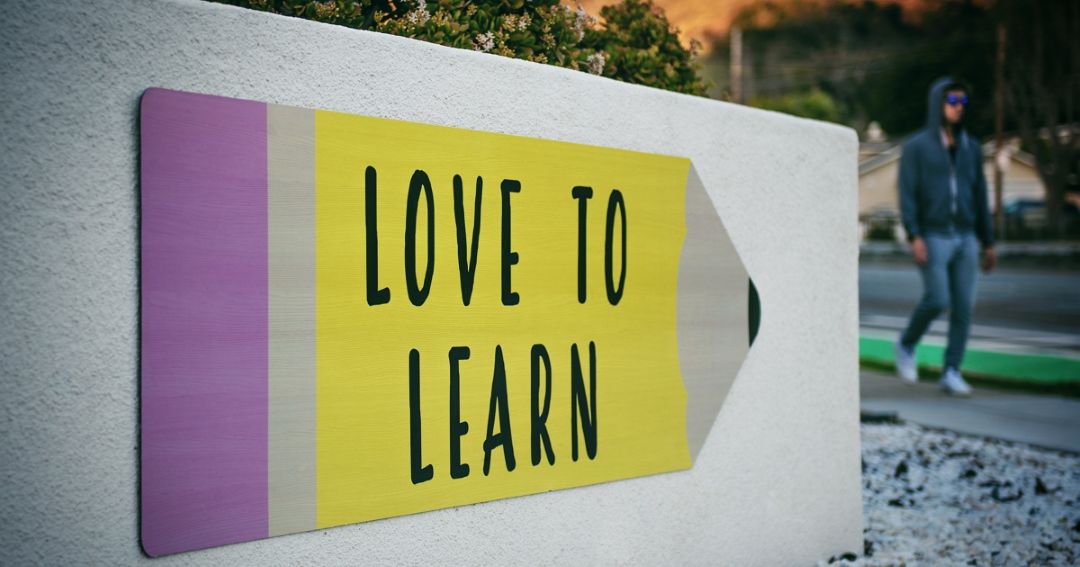
In this article
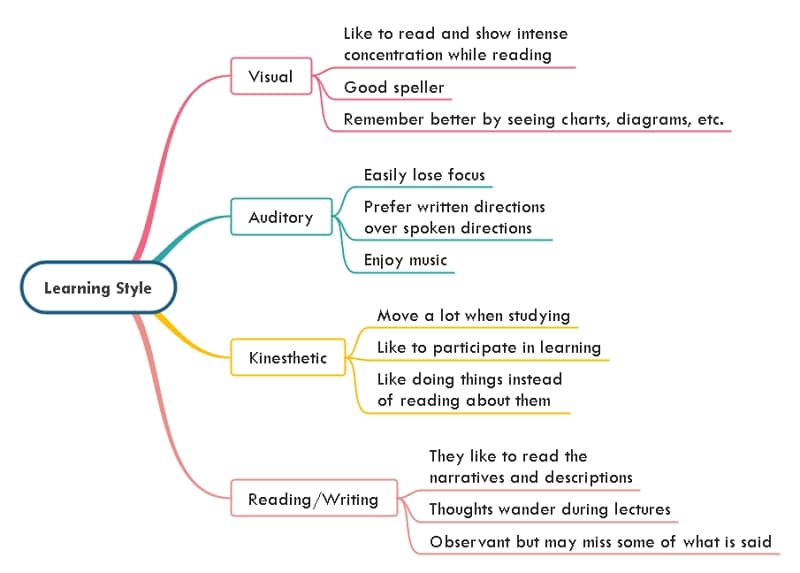
What Are Learning Styles?
People all view the world in various ways, adding inherent variability in our learning styles. Understanding learning style variations will have a significant impact on how teachers approach their pupils, organize community events, and engage with the learning process.
There are four common types of learning styles: visual, auditory, kinesthetic, and reading/writing learning.
By knowing their differences, teachers may end up with a couple of students lagging behind their classmates, in part because they haven't triggered their particular learning style.
Types of Learning Styles
Here are some different types of learning styles.
Auditory Learners
Auditory pupils prefer to understand more through sound and listening. These students will rather listen to a speech than read written notes, and also use their voices to develop novel ideas and concepts.
They want the information to be read or recited and benefit from auditory repetition. Common characteristics among these learners are:
- Easily losing focus
- Prefer written directions over spoken directions
- Enjoying music
Kinesthetic Learners
It is by experiencing or doing things that kinesthetic learners, or "tactile" learners, understand and process information. These are the students who may struggle to sit still, excel in athletics, enjoy dancing, or require breaks during learning.
They remember best what was done, rather than what they heard or thought of. Common characteristics among these learners are:
- Moving a lot when studying;
- Participating in learning activities; and
- Doing things instead of reading about them.
Reading/Writing Learners
Reading/writing learners tend to learn by written words. Although there is some overlap with the visual learning style, these types of learners are drawn to expression by writing, reading articles on the internet, writing in diaries, and looking up words in the dictionary.
Common characteristics among these learners are:
- Like to read the narratives and descriptions
- Thoughts wander during lectures
- Observant but may miss out on a few things
Visual Learners
Someone with a visual learning style is partial to seeing and observing things, including images, diagrams, written directions, and more. Students who learn by seeing are better at recognizing knowledge as it is viewed visually.
Visual learners prefer to use charts, maps, graphs, diagrams, and more to take in information. The most effective way to engage a visual learner is through the use of images to explain concepts and ideas.
The type of learning style does not, however, contain photos or pictures.
Traits of Visual Learners
They have a more immediate recall of the words that are visually presented. Visual learners are fond of taking notes. They consciously solve problems, prepare their ideas in advance, and arrange them by writing them down. They enjoy reading narratives.
- Thoughts wander during conferences
- Enjoy reading and displaying deep focus while reading
- Good speller
- Recall better by viewing charts, diagrams, etc.
Benefits of the Visual Learning Style
In ordered linear forms, seminars, videos, and textbooks show all the knowledge, with a beginning, middle, and end.
This is excellent for delivering information, but it requires different cognitive processes to synthesize and integrate new information – that is the key to deep learning.
This is where the visual learning style and mapping of the mind come into the picture. Mapping helps students collect concepts and incorporate information in an unstructured or undefined order, often in multi-sensory ways.
How To Apply Visual Learning Strategies
For learning:
Visual learners can remember 75% of what they see or read, so they take extensive notes. They get a strong sense of direction as they can read maps. Their passion for equilibrium means they prefer to be cool.
- See headings and pictures before completing whole sentences
- Highlight the main words in color
- Write down your notes and use graphs, maps, and charts whenever possible
- Using brainstorming diagrams and mind maps to illustrate how everything you're doing fits together.
For teaching:
The following tips can help teachers effectively support students with a visual learning style.
- To present information, such as PowerPoint presentations, videos, and photos, utilize various technologies.
- With headings and pictures, the coordinate details well.
- Let the student be creative and use the imagination he has.
- Ask students to close their eyes after reading information so that they can picture what they've just learned.
Tips for Using Learning Styles
- Auditory → Record, Recite, Repeat
- Kinesthetic → Practice, Move, Experiment
- Reading/Writing → Read, Rewrite, Summarize
- Visual → Highlight, Diagram, Map
More tips:
- Know your style – Match your study habits to what fits you best.
- Mix methods – Combining styles (like visual + reading) strengthens memory.
- Review actively – Instead of rereading, summarize or quiz yourself.
- Stay balanced – Take breaks, get enough rest, and stay hydrated.
- Use a mind map – It visually links ideas, keeps learning organized, and aids recall.
How To Boost Efficiency With a Mind Map
Using visual mind maps is the key to better organizing learning. They turn scattered notes into clear connections, making it easier to remember and review important ideas quickly.
Mind maps also save time. Instead of flipping through pages, you see the big picture at a glance. Visual layouts make study sessions more focused, structured, and less overwhelming.
Why mind maps work:
- Organization – Breaks down complex topics into clear branches.
- Memory – Helps recall through visual structure.
- Focus – Keeps study sessions less cluttered.
Mind maps are one of the most powerful tools for learners, especially visual thinkers. They transform long notes into simple diagrams that clearly show connections.
To try it yourself, use Wondershare EdrawMind. This easy-to-use tool helps you create visual mind maps for any subject. Organize knowledge smarter, study faster, and enjoy learning more.
How To Create a Mind Map
Step 1: Create a blank mind map
Open EdrawMind and click Create > Blank Mind Map from the dashboard.
- Select whether you want a local file or a cloud-based workspace.
- Rename your file immediately for easier organization.

Step 2: Start with a central theme (e.g., Learning Styles)
- Double-click the central node and type the theme.
- Adjust font size or color to make it the main focus.
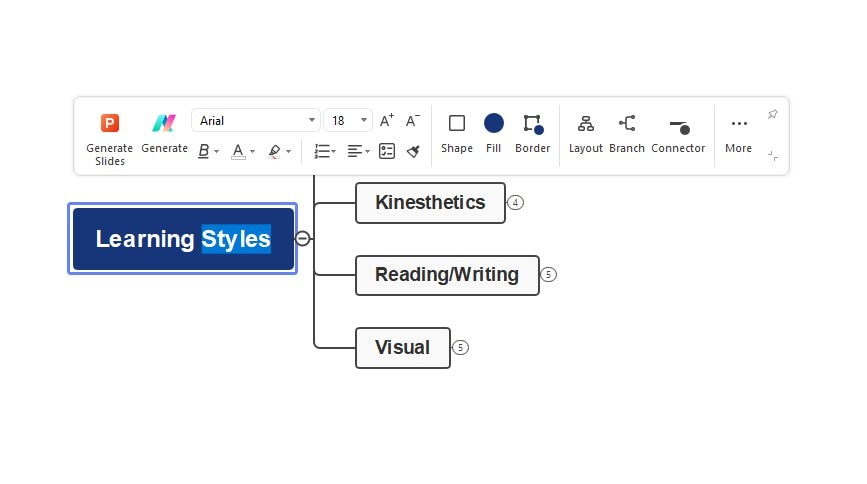
Step 3: Add the main branches
- Add branches labeled Auditory, Kinesthetic, Reading/Writing, and Visual.
- Press Enter to add more main branches, or Tab to insert subtopics.
- You can use colors or icons to differentiate each branch for clarity.
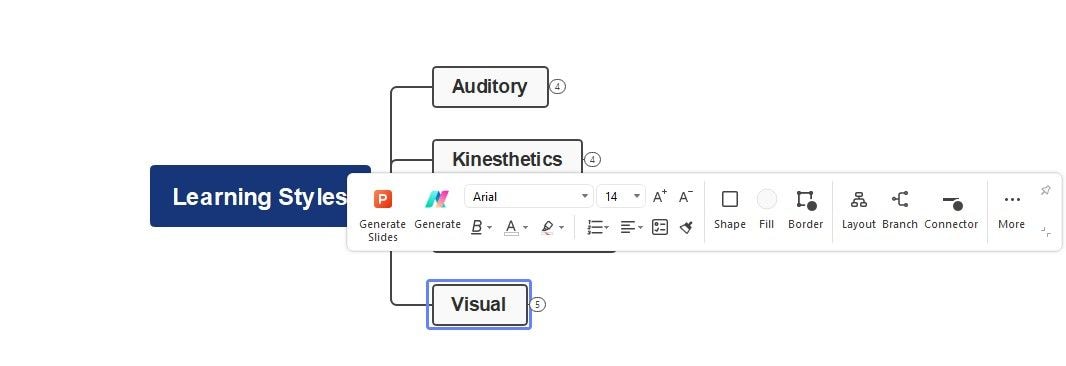
Step 4: Customize your diagram
- Change the theme or layout to match your preferred style.
- Add images, icons, or links for extra information under each force.
- Use notes and attachments to include supporting data and references.
Step 5: Export and share your work
- Export the diagram to PDF, JPG, Word, or PowerPoint for easy sharing.
- Share directly with colleagues using links or cloud-based collaboration tools.
- Save the file as a template to facilitate your learning process.
FAQ
-
How do I know what type of learner I am?
Online quizzes can suggest your preferred style, but many users say those tests conflict.
“First quiz said I’m kinesthetic, second said visual … I lean auditory in practice.”
People often try multiple methods and see which “feels” best.
-
Do students really learn better if taught in their “learning style?”
Some teachers argue that learning styles are more a matter of preference than a scientific fact. Many say mixing visual, auditory, and hands-on methods tends to work better than sticking to just one.
-
Can my learning style change over time or across subjects?
Yes. Many people report using one style in some subjects and another in others. For example, you might prefer a visual approach in history but a kinesthetic approach in physics labs.
-
Should teachers force every style in lessons?
Some forum contributors caution that rigidly designing lessons around individual styles is unhelpful. Instead, offering multiple modes (lectures, visuals, and hands-on) increases engagement and reaches a broader range of learners.
-
Why do people still talk about learning styles if the evidence is weak?
One strong reason is culture and belief. Many teachers and students believe in learning styles even though the scientific support is minimal. They serve as a framework to start conversations about preference and differentiation.



